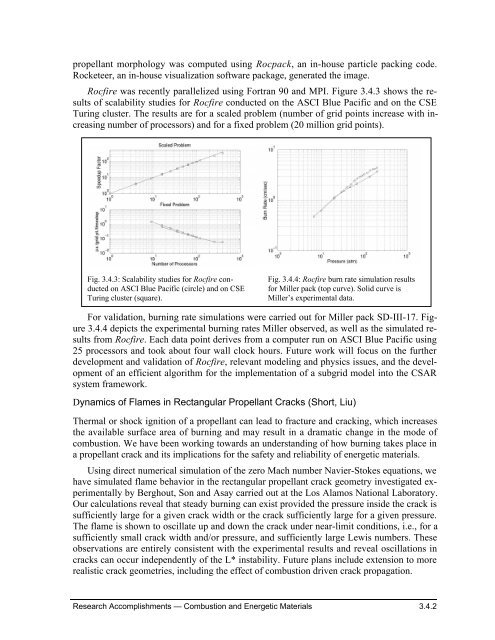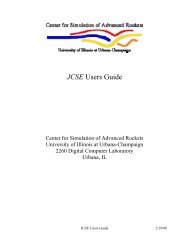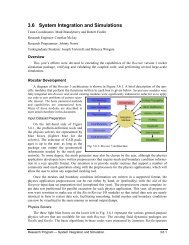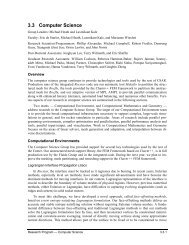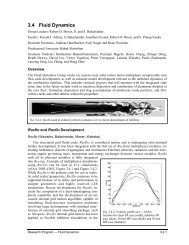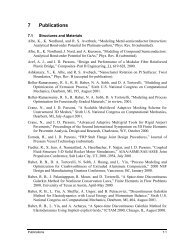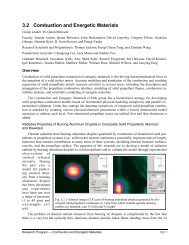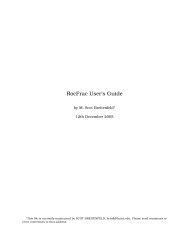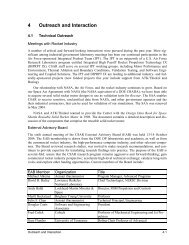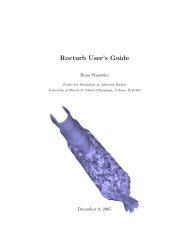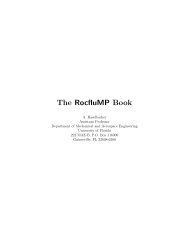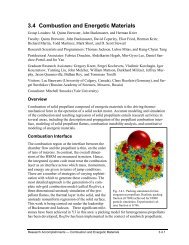3.4 Combustion and Energetic Materials
3.4 Combustion and Energetic Materials
3.4 Combustion and Energetic Materials
You also want an ePaper? Increase the reach of your titles
YUMPU automatically turns print PDFs into web optimized ePapers that Google loves.
propellant morphology was computed using Rocpack, an in-house particle packing code.<br />
Rocketeer, an in-house visualization software package, generated the image.<br />
Rocfire was recently parallelized using Fortran 90 <strong>and</strong> MPI. Figure <strong>3.4</strong>.3 shows the results<br />
of scalability studies for Rocfire conducted on the ASCI Blue Pacific <strong>and</strong> on the CSE<br />
Turing cluster. The results are for a scaled problem (number of grid points increase with increasing<br />
number of processors) <strong>and</strong> for a fixed problem (20 million grid points).<br />
Fig. <strong>3.4</strong>.3: Scalability studies for Rocfire conducted<br />
on ASCI Blue Pacific (circle) <strong>and</strong> on CSE<br />
Turing cluster (square).<br />
Fig. <strong>3.4</strong>.4: Rocfire burn rate simulation results<br />
for Miller pack (top curve). Solid curve is<br />
MillerÕs experimental data.<br />
For validation, burning rate simulations were carried out for Miller pack SD-III-17. Figure<br />
<strong>3.4</strong>.4 depicts the experimental burning rates Miller observed, as well as the simulated results<br />
from Rocfire. Each data point derives from a computer run on ASCI Blue Pacific using<br />
25 processors <strong>and</strong> took about four wall clock hours. Future work will focus on the further<br />
development <strong>and</strong> validation of Rocfire, relevant modeling <strong>and</strong> physics issues, <strong>and</strong> the development<br />
of an efficient algorithm for the implementation of a subgrid model into the CSAR<br />
system framework.<br />
Dynamics of Flames in Rectangular Propellant Cracks (Short, Liu)<br />
Thermal or shock ignition of a propellant can lead to fracture <strong>and</strong> cracking, which increases<br />
the available surface area of burning <strong>and</strong> may result in a dramatic change in the mode of<br />
combustion. We have been working towards an underst<strong>and</strong>ing of how burning takes place in<br />
a propellant crack <strong>and</strong> its implications for the safety <strong>and</strong> reliability of energetic materials.<br />
Using direct numerical simulation of the zero Mach number Navier-Stokes equations, we<br />
have simulated flame behavior in the rectangular propellant crack geometry investigated experimentally<br />
by Berghout, Son <strong>and</strong> Asay carried out at the Los Alamos National Laboratory.<br />
Our calculations reveal that steady burning can exist provided the pressure inside the crack is<br />
sufficiently large for a given crack width or the crack sufficiently large for a given pressure.<br />
The flame is shown to oscillate up <strong>and</strong> down the crack under near-limit conditions, i.e., for a<br />
sufficiently small crack width <strong>and</strong>/or pressure, <strong>and</strong> sufficiently large Lewis numbers. These<br />
observations are entirely consistent with the experimental results <strong>and</strong> reveal oscillations in<br />
cracks can occur independently of the L* instability. Future plans include extension to more<br />
realistic crack geometries, including the effect of combustion driven crack propagation.<br />
ðResearch Accomplishments Ñ <strong>Combustion</strong> <strong>and</strong> <strong>Energetic</strong> <strong>Materials</strong> <strong>3.4</strong>.2


